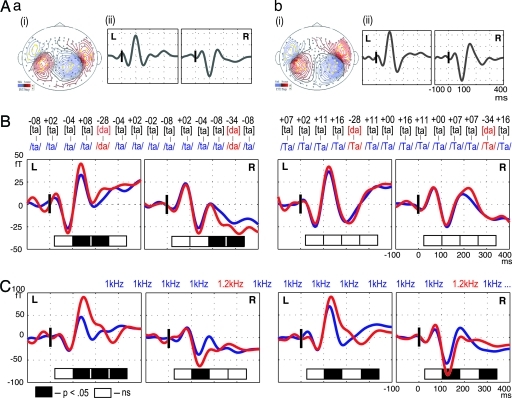Fig. 3.
Tone pretest, Speech condition, and Tone condition. (A) Tone pretest. (Ai) Averaged evoked response to 1-kHz tone in Russian (a) and Korean (b) language groups, showing dipolar scalp distribution of N100m response in each hemisphere for a representative participant in each group. Yellow dots indicate the seven MEG channels with the largest N100m amplitude at each field maximum. For each participant, these channels were used for the analysis of the Tone and Speech conditions. (Aii) Grand average N100m response from seven posterior channels per hemisphere (n = 13 in each group). (B) Speech condition. Each language group listened to sequences of syllables drawn from similar [da] and [ta] categories, each consisting of multiple tokens with different VOT values (upper row). The acoustic and phonetic encoding of the syllable sequences was comparable across languages, but Korean lacks the contrast at the phoneme level because [d] and [t] are allophones of the single phoneme category /T/. The waveforms represent the grand average brain response from seven left-posterior and right-posterior channels across two blocks. Black rectangles in each graph indicate the locus of significant differences, as indicated by a one-way ANOVA performed in four 80-ms-long windows (from 20 to 340 ms) within individual scalp quadrants. Russian speakers showed a significant divergence between responses to standard (blue) and deviant (red) categories, whereas Korean speakers did not. Because of the use of multiple nonorthogonally varying tokens of each category, a many-to-one ratio among stimuli was absent at the acoustic level for both language groups and available at the phonemic level only for Russian speakers. Therefore, the presence of an MMNm in Russian but not in Korean speakers provides evidence that auditory cortex can group sounds based on phonemic but not allophonic categories. (C) Tone condition. For the same MEG channels in the same two groups of speakers, grand averaged brain responses to a standard 1-kHz (blue) and a deviant 1.2-kHz (red) tone are shown. A typical N100m response followed by an MMNm to the deviant tones was found in both language groups.

